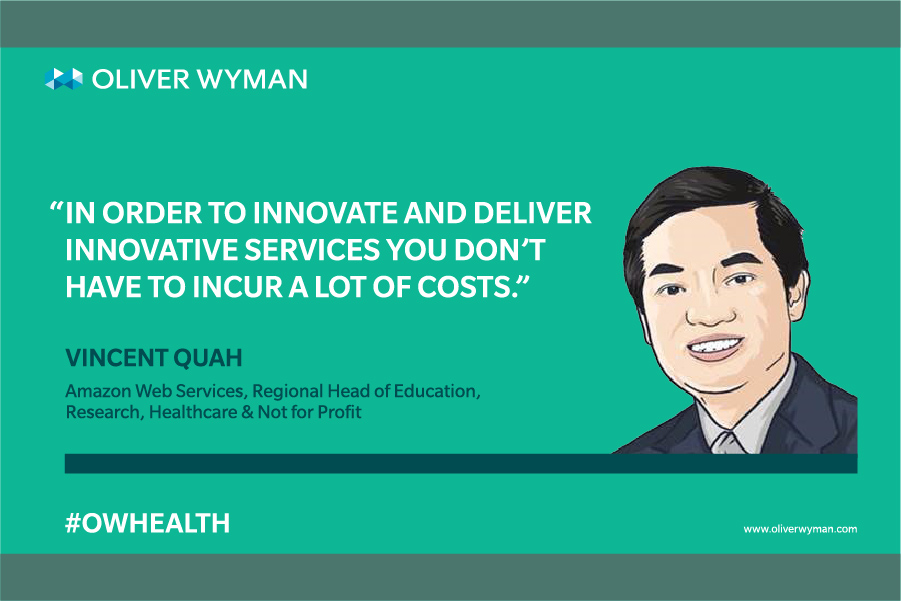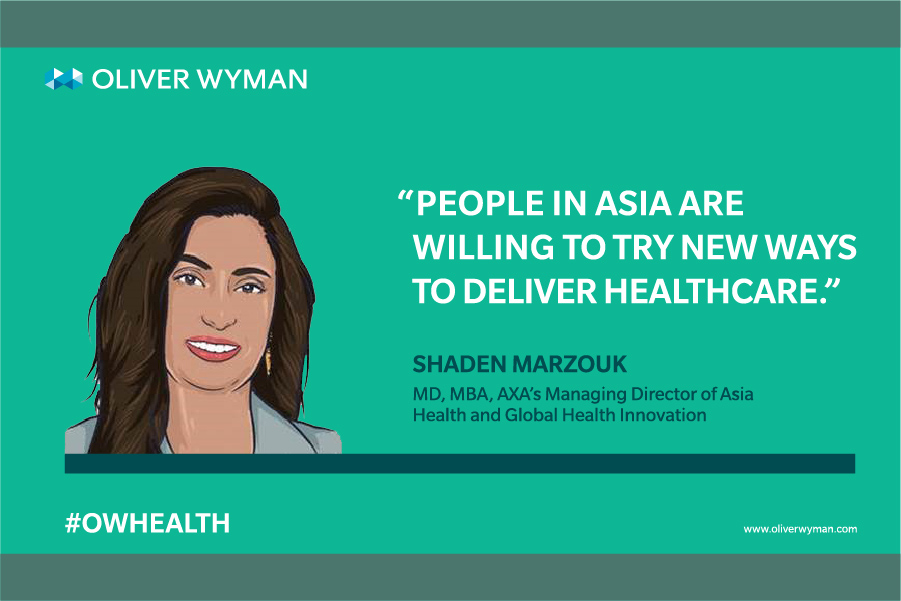They say breakfast is the most important meal of the day. It can also be the most innovative meal of the day. Earlier this month in Singapore, Oliver Wyman hosted an exclusive breakfast event for tech experts and cross-industry executives in industries like health and finance – the second annual Asia edition of the Oliver Wyman Health Innovation Summit. This event featured keynotes from global experts to help attendees build for impact and design healthcare ecosystems across Asia – a sector and region where much work remains to be done that hasn’t yet seen the same kind of disruption (for example, mega mergers like CVS-Aeta or Haven) like the United States has. Conversations from global leaders swirled that morning around topics like innovation in health ecosystems, opportunities for impact, how technology is becoming more infused into a wide array of industries, Asia’s high consumer digital adoption, and how healthcare in this part of the world is relatively unencumbered by traditional brick-and-mortar models. One of the biggest specific key takeaways? The possibilities of new health ecosystems and care models are here (and, they’re here to stay).
Here’s more on what two of our panelists – Vincent Quah (Amazon Web Services’ Regional Head of Education, Research, Healthcare & Not for Profit) and Shaden Marzouk, MD, MBA (AXA’s Managing Director of Asia Health and Global Health Innovation) – told attendees about the greater state of Asian healthcare and the emerging health ecosystem role tech and insurers may play in time.
Q&A with Vincent Quah
Oliver Wyman Health (OWH): How do technology players like AWS enable a health ecosystem? How is that relevant within an Asian context?
Vincent Quah (VQ): From an Amazon Web Services (AWS) perspective, technology ties different players together and connects the dots in as seamless a way as possible. In order to achieve integration between all players, you need a strategy for providing technology that can establish interoperability across different systems and stakeholders.
In Asia, the market is still in early developmental stages. But there are some key opportunities in areas like precision medicine and clinical care. For example, Seoul National University Hospital uses a precision medicine platform called Syapse to bring genomic data, patient data, and clinical data into a single environment which can then run analytics to understand correlation between the genetic makeup and the cancer phenotype of a particular patient. This is then tied into the administration of clinical drugs so the hospital can provide better patient care. Other examples of more digital health businesses in the region include Halodoc, Dr. Lal PathLabs, and Medlife.
OWH: What kind of value proposition for AWS is specific to healthcare? Are there other specific components at the top of the list?
VQ: In many parts of Asia, hospitals do not necessarily have the ability to make investments that will put them at the cutting edge of providing care. Many health players are behind on technology investments – there is a lot of technical debt and trying to put in additional investment may be a challenge for them.
Fifty-four percent of healthcare company Chief Executive Officers say transitioning from volume to value healthcare provision is their biggest financial challenge. What this means is they cannot set aside investments for what you would really call “driving innovation”. AWS helps bridge that gap by providing the underlying core suites of services so they can focus on innovation.
We believe in order to innovate and deliver innovative services, you don't have to incur a lot of costs. Hospitals are adopting cloud services, as they are suitable for experimentation and innovation. You don't know whether the experiment is going to be successful or is going to fail. In fact, probably 90 percent of the times you will fail and perhaps you'll be successful 10 percent of the time. What you want to do is to experiment and fail as cheaply as possible, and using the cloud is one way to do that.
To enable that, AWS provides services that are on demand, which means they are always available whenever you need it. Secondly, it is a pay-as-you-go model, which means you only pay for what you use. As a user, regardless of your size and maturity, you will have the same access to a whole range of services from core cloud services like computing, storage, databases, networking, all the way to advanced technologies like analytics, artificial intelligence and machine learning.
OWH: What is the role of AWS in furthering the customer journey?
VQ: From an AWS perspective, we focus on our strengths in the technology platform to build services our customers can benefit from. We work with our customers to understand which services they should adopt, and develop solutions that would meet their needs. We always work with customers to address their core business challenges. Oftentimes, we also need to bring in a system integrator to help bring different pieces of technologies together.
Healthcare is such a wide domain and you cannot be an expert in everything. So, we work hard to understand the pain/issues our clinicians, doctors, hospital administrators, and all our customers go through – and then focus on bringing the right technology and partnering to help bridge that gap between the business requirements and to help solve the problems identified.
OWH: What will Asia’s future look like? What will become hotspots of activity, versus roadblocks, and how can technology play a part?
VQ: There is a higher percentage of people in Asia willing to share data on healthcare type of endeavors, compared to their Western counterparts. So, the appetite to try new things and to innovate is certainly present. And that makes Asia a bright spot in the economy. A good example of a country that leapfrogged technology adoption is Myanmar with mobile phones, and we could do something similar here in healthcare.
OWH: What regulatory or government factors will companies like AWS have to address or overcome?
VQ: One area is data. However, our recommendation to countries is to not reinvent the wheel. For example, the Health Insurance Portability and Accountability Act of 1996 (HIPAA) is already a known and well tested framework readily adopted by the major US players and provides such a strong level of security compliance and controls. It, or similar models in the United Kingdom, for example, can serve as a base, and the policy makers can adopt these frameworks as a first step. The same can be done in Asia - if Asia adopts similar data regulations, that will also enable it to adopt innovations from elsewhere.
Q&A with Shaden Marzouk
OWH: What role do insurers play within the healthcare ecosystem? How can they innovate further?
Shaden Marzouk (SM): Insurers are in a great position to connect all the parts of the value chain in the healthcare system. We should use that role to solve issues for our customers such as cost, quality, and access. We have the ability to find ways to make healthcare affordable, make sure that the healthcare being delivered is high quality, and find efficient ways for our customers to access care.
When we think about putting together our propositions and solutions, we seek to address these issues for members. The Asian market has a dynamic, fast-paced environment and very prevalent mobile use and digital adoption – people here are already accustomed to a consumer experience through their mobile phones. Therefore, we have the opportunity and need to continue to innovate the consumer experience – to strive to make things just as easy and efficient in healthcare and insurance as in other industries.
OWH: What has been your impression of Asia as a testing bed for innovation? Do you see more opportunities arising?
SM: People in Asia are willing to try new ways to deliver healthcare. We can be very advanced in Asia when we think about how to design the right customer journey and what we can do to make healthcare more digital and more transparent.
It’s important people understand their healthcare, what their treatment plan means, and what makes their doctor the highest quality provider. My vision is for people to clearly understand what their insurers offer, what the services and solutions do, and to have the tools and transparency to make decisions around their care. When I talk about transparency, I mean customer education. And obviously the element of cost – providing information that allows customers to understand their healthcare expenses and realize opportunities to identify, and even purchase, something that offers more value. And that this information becomes important parts of a decision.
OWH: What challenges hinder these ambitions?
SM: One big opportunity in Asia, particularly within emerging markets, is the prevalence of people who have private health insurance. For example, in China and parts of Southeast Asia like the Philippines, Thailand, and Indonesia, this number is comparatively lower.
People are learning how health insurance works, and how this can be a solution for their healthcare needs and a way to access the best healthcare. Customers need help thinking about insurance as something beyond a payment vehicle, instead as a series of services that help them find the best cost, quality, and access to healthcare. The solution to this involves many things, including branding and marketing and creative customers outreach to help people become aware of the opportunities that private health insurance provides.
OWH: What are some specific examples, from an Asian context, where you see innovation successfully impacting the cost, quality, or access of healthcare services?
SM: Telemedicine is one great way. We are offering telemedicine in our countries across Asia and this is a great way to make healthcare affordable through something that has an accustomed digital mobile experience, with high quality doctors delivering top quality healthcare. Of course, what could be more accessible than being able to contact your doctor over your phone, on demand? But, as with any solution, it’s not just about the solution but adoption.
And for telemedicine in this region, there are two main hurdles. First, it’s just trying it. There are many questions in customers’ minds and sometimes an initial lack of trust, but once people actually use telemedicine, they continue to utilize it at a higher rate than those who just simply signed up for the service. When I think about the future, I see the inflection points are moving already towards more adoption.
Second, to make this a good customer experience – can a telemedicine provider also offer direct delivery and other services beyond just the consult? If you're seeking the convenience of medical attention on your phone, you generally don't also want to be inconvenienced by having to go to a pharmacy or deal with a paper prescription. We are working through these already and I’m excited by the possibilities around this.
OWH: “Innovation” and “scale” are often mentioned together in the same breath. What’s your perspective on how these two ideas are often intertwined?
SM: Yes, scale of innovations often crops up. From AXA’s own experience with partners of smaller scale, for instance, like some of our telemedicine partners, this is not a deterrent. Smaller partners are often the equation when we think about how to accelerate our ability to offer new services to customers. We also have a role to help new companies achieve greater customer access along with a dual responsibility to our own customers to provide innovation.
Within the Asian context, some hotbeds for innovation and new digital solutions for health are China, as well as countries with a digital entrepreneurial spirit such as Indonesia and the Philippines.
OWH: How do you see the customer’s journey evolving? And, what is the biggest opportunity for insurers?
SM: Customers just want simplicity. People don't want to be clicking in and out of five apps to do healthcare – whether it's accessing an appointment, seeing an actual provider, getting e-prescriptions, sending out remote monitoring data, receiving care coordination, or getting a claim reimbursed. They want one platform.
In Asia, AXA’s insurance business is already highly business-to-consumer. We have a big retail business and this is an experience that we intend to carry forward in terms of learning from other industries innovating the digital customer journey. The customer experience will become more personalized because of all the touches we have with customers throughout their healthcare journeys. We permissibly interact with customers not only at the time they buy or enroll in a policy, but when there's a diagnosis, when there's access to telemedicine or care coordination or other interventions, and when there is access to wellness and prevention and more – the touch points along the whole care continuum.
OWH: Do you see a prospect of insurers moving away from traditional business towards other products like “digital hospitals”?
SM: Our campaign is to transform from payer to partner – the goal is not be thought of as simply insurance, but as the one-stop-shop for your healthcare needs. We want to be the partner for everything from prevention to intervention. We want people to truly know that AXA can be there and help you figure out – for example - who the right doctor is, where to go and how things are going to get paid for, as well as what encounters can be online and convenient. AXA’s ambition is to be a digitally enabled health partner for all our members.
Editor's Note: Read our Mercer Marsh Benefits / Oliver Wyman Health on Demand Survey here.





